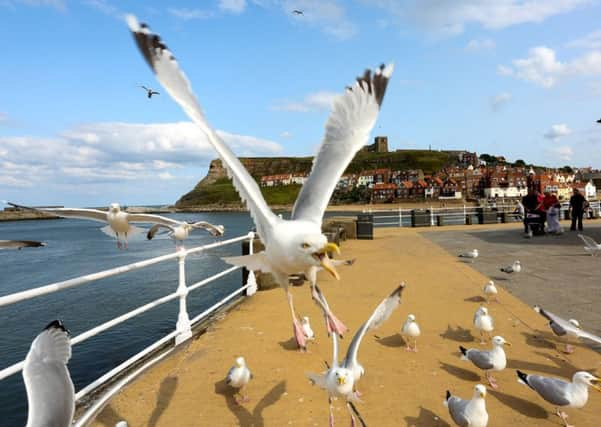Action plan to tackle Scarborough's and Whitby's nuisance seagulls


A report has been drawn up by Scarborough Borough Council (SBC) to tackle the menace of the opportunist gulls - which would involve bringing in birds of prey to scare off the smaller animals.
The scheme, to be debated next week, would run over at least six years and would see specialists removing the nests to “disrupt and disperse” the nuisance birds.
Advertisement
Hide AdAdvertisement
Hide Ad“I don’t believe in killing any animals, just because they’re a disturbance and a nuisance,” said Coun Bill Chatt, cabinet member for the environment. “But I am up for this new proposal - I do think it will be a lot better.
“We want to encourage people to come to Scarborough, have their chips and their candyfloss and swim in the sea, without being swamped by these seagulls. They can be quite terrifying to a child. When these seagulls are ‘mugging’ people, and upsetting people, we’ve got to try and do what we can.”
The blight of the nuisance gulls has been well documented in recent months, with SBC even starting a record of the number of ‘muggings’ of incredulous residents and tourist.
The seagulls, bold after years of urban living, have risen significantly in number and become increasingly pesky - particularly in the Scarborough bay and Whitby harbour areas.
Advertisement
Hide AdAdvertisement
Hide Ad“I’m told they live up to 30 years, and they’re clever - they have learned a lot,” said Coun Chatt. “They’ve learned that when a little boy walks out of a chip shop, it’s easy pickings.
“Seagulls are clever. If they go to an all-you-can-eat buffet, they will. They aren’t going to go out and start fishing again.”
The action plan, drawn up after months of research and the establishment of a special task force, sets out several measures to tackle the problem.
Letters have already been sent to 3,000 businesses, advising them on ‘proofing’ methods to deter kittiwakes from nesting. And in the lead up to this year’s high season, the authority proposes to start rolling out more prominent signage for bins, railings and street lamps - even exploring options to print messages on the insides of chip boxes to warn tourists not to feed the gulls. Key to the plan is the move to employ specialist agencies to disrupt and disperse the gulls, with a starting cost of £36,500 a year from 2017/18.
Advertisement
Hide AdAdvertisement
Hide AdThis process would involve removing herring gull eggs and nests from buildings and bringing in birds of prey such as Harris Hawks and falcons, to deter and scare them away.
“I’m keen to try it,” said Coun Chatt. “This would displace them from the properties and put them back on the cliff. That’s where they should be.”
The action plan is to go before SBC’s Overview and Scrutiny Board next Wednesday for approval. If passed, it would have to go to cabinet to secure funding.
A task group was set up in 2015 to tackle the issue of the nuisance gulls, setting out initial measures to clean up the streets and promote education.
Advertisement
Hide AdAdvertisement
Hide AdSince March 2016, there have been 36 reports of ‘muggings’ made to the authority. Coun Godfrey Allanson, who was chair of the task force, said he himself witnessed a bird swoop down and steal cheese straws from the hands of a man right in front of him.
“The herron gulls are attacking people for the food in their hands,” he said. “The difficulty is in people, on seeing the gulls, throw them a couple of chips. They are associating people with food.”
Key to solving the issue is in education, he said.
“We’ve had instances of them attacking a child - it is a big problem. We have to try and do what we can to discourage them.”